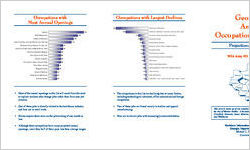Occupations with Most Annual Openings
Cashiers Retail Salespersons Waiters & Waitresses Comb. Food Prep. & Serving Workers, Incl. Fast Food Elementary School Teachers, Ex. Spec. Ed. Laborers & Freight, Stock, & Material Movers, Hand General & Operations Managers Stock Clerks & Order Fillers Teacher Assistants Truck Drivers, Heavy & Tractor-Trailer Office Clerks, General
Registered Nurses Farmers & Ranchers Postal Service Mail Carriers
Team Assemblers
70 70 60 60 60 60 50 50 40 40 40
170 140 120 110
Most of the annual openings in this list will result from the need to replace workers who change jobs rather than from new job creation.
One of these jobs is directly related to the healthcare industry and four are in retail trade.
Eleven require short-term on-the-job training of one month or less.
Although these occupations have many projected annual openings, more than half of them pays less than average wages.
Occupations with Largest Declines
-360
-250
-110 -90 -70 -60 -60 -60 -50 -50 -40 -40 -30 -30 -30
Postal Service Mail Carriers Postal Serv. Mail Sorters, Processors, & Process. Mach. Opers. Secretaries, Except Legal, Medical, & Executive Postal Service Clerks Sew ing Machine Operators Inspectors, Testers, Sorters, Samplers, & Weighers Procurement Clerks Word Processors & Typists Aircraft Mechanics & Service Technicians Dishw ashers Maids & Housekeeping Cleaners Operating Engineers & Other Const. Equipment Operators Cooks, Fast Food Sheet Metal Workers Textile Wind., Tw ist., & Draw . Out Mach. Setrs., Opers., & Tndrs.
The occupations in this list are declining due to many factors, including technological advances, office automation and foreign competition.
Two of these jobs are found mainly in textiles and apparel manufacturing.
Four are in clerical jobs with increasingly automated duties.
Georgia Area
Occupational Trends
Projections to 2010
WIA Area #11 Middle GA
This area is made up of ten counties in middle Georgia in and around the city of Warner Robins. It includes the following counties: Baldwin, Crawford, Houston, Jones, Monroe, Peach, Pulaski, Putnam, Twiggs and Wilkinson.
Workforce Information & Analysis Division Georgia Department of Labor Michael L. Thurmond Commissioner
Total employment in WIA Area #11 is expected to reach more than 113,500 jobs by the year 2010, with almost 1,000 new jobs added each year. The area's economy is currently lagging behind both the state's and the nation's economy. Area job growth is expected to be 0.9 percent per year, while Georgia's job growth is expected to be 1.8 percent per year and the nation is expected to have annual job growth of 1.4 percent.
Area Highlights
This area is home to two regional medical centers, a state psychiatric hospital, several colleges and universities, and a large military base.
There is also significant employment in aircraft and bus equipment manufacturing.
This area's main industries are health services, higher education services, federal government employment, and transportation equipment manufacturing.
This area experienced population growth of 19.3 percent, while Georgia experienced population growth at a rate of 25.8 percent overall during the years 1990-2000.
This area witnessed total personal income growth of 70.1 percent, during which time the state saw total personal income grow at a rate of 98.2 percent.
For copies of the Georgia Career Planner, Georgia Occupational Trends in Brief
or this publication, call 404/232-3875 or contact your local
Department of Labor office.
Fastest Growing Occupations
Truck Drivers, Heavy & Tractor-Trailer Child Care Workers
Comb. Food Prep. & Serving Workers, Incl. Fast Food Teacher Assistants
Secondary School Teachers, Ex. Spec. & Voc. Ed. Laborers & Freight, Stock, & Material Movers, Hand
Cashiers Team Assemblers General & Operations Managers Waiters & Waitresses Retail Salespersons Food Preparation Workers Elementary School Teachers, Ex. Spec. Ed. Farmers & Ranchers Off ice Clerks, General
2.4% 2.3% 2.2% 2.1% 1.8% 1.7% 1.7% 1.7% 1.6% 1.6% 1.6% 1.3% 1.3% 1.1% 1.0%
These fast-growing occupations will have better employment prospects than occupations with slow or declining employment. Also, conditions will be more favorable for mobility and advancement.
Three of the fastest growing occupations are in the K-12 educational services industry.
Twelve of these occupations do not require any formal education beyond high school.
Occupations with Largest Job Growth
Cashiers Retail Salespersons Truck Drivers, Heavy & Tractor-Trailer Comb. Food Prep. & Serving Workers, Incl. Fast Food Customer Service Representatives Teacher Assistants Waiters & Waitresses Farmers & Ranchers General & Operations Managers Elementary School Teachers, Ex. Spec. Ed. Laborers & Freight, Stock, & Material Movers, Hand Computer Support Specialists
Team Assemblers Child Care Workers Suprvsrs. of Retail Sales Workers
500 430 390 330 290 290 290 280 280 250 240 220 220 170 170
These 15 occupations out of more than 700 - are projected to add more than 4,300 jobs over the next 10 years, about 44 percent of all projected job growth in this area.
Ten occupations require short-term on-the-job training of one month or less and two require a bachelor's degree.
One of these occupations is associated with computer technology.
Equal Opportunity Employer/Program Auxiliary Aids and Services Available upon Request to Individuals with Disabilities
